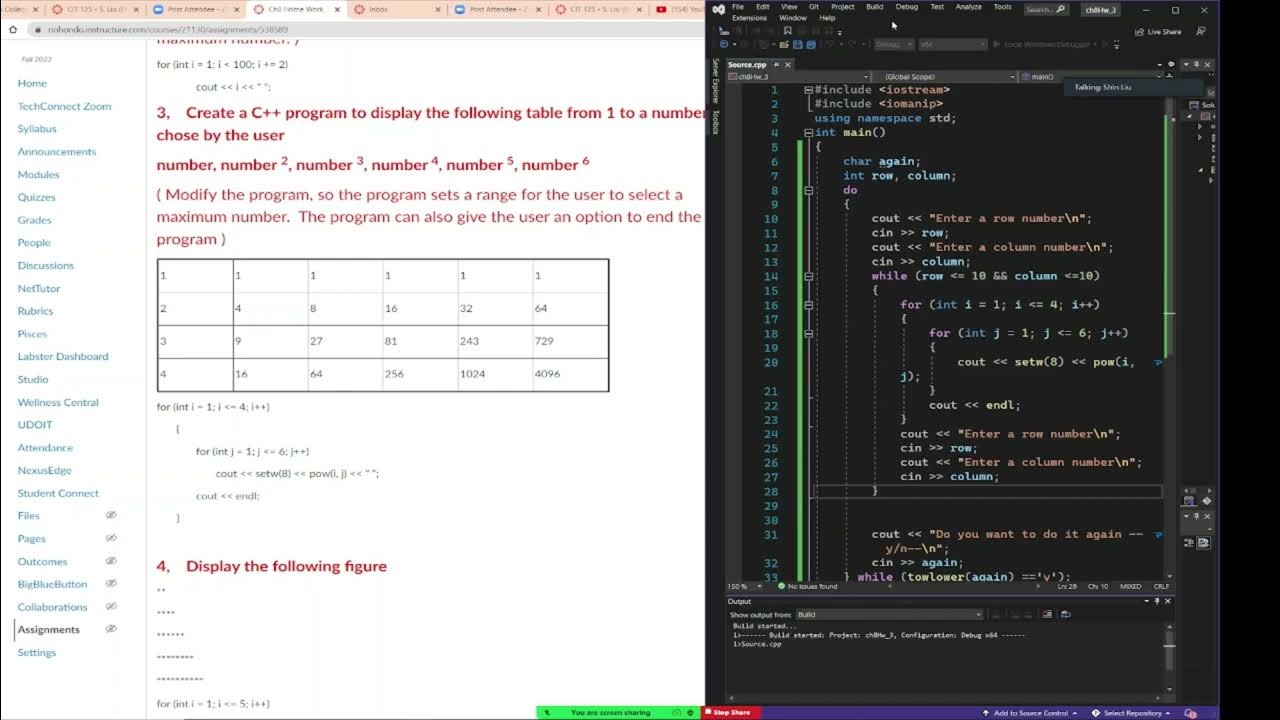C++ programming, Nested For Loop Introduction
Summary
TLDRIn this informative tutorial, Professor Liu introduces the concept of loops in programming, focusing primarily on 'for' loops. He explains the differences between single, double, and triple loops, emphasizing their practical applications in handling multi-dimensional arrays. Through hands-on coding examples, he demonstrates how to use loops to print repeated characters and draw user-defined shapes like squares. The session also highlights the importance of input validation and error handling, ensuring users provide acceptable values for drawing parameters. Overall, the tutorial is a comprehensive guide to mastering loops and enhancing programming skills.
Takeaways
- 😀 For loops are essential programming structures used to repeat a block of code a specified number of times.
- 😀 A single for loop iterates over a defined range, while nested for loops allow for multi-dimensional iterations.
- 😀 Two-dimensional loops (2D) involve two variables, while three-dimensional loops (3D) involve three variables (x, y, z).
- 😀 Using for loops is more efficient than while loops when the number of iterations is known beforehand.
- 😀 The example of displaying dollar signs demonstrates how to use for loops to repeat actions multiple times.
- 😀 User input validation is crucial for ensuring that only acceptable values are processed in the program.
- 😀 Implementing a control structure, such as a while loop, can help manage user input and re-prompt for corrections when necessary.
- 😀 Users should be able to specify their preferred symbol and size when drawing shapes in the program.
- 😀 Proper error handling allows the program to block invalid inputs until correct values are entered.
- 😀 The integration of loops and conditionals creates dynamic and user-friendly programming experiences.
Q & A
What is a for loop, and why is it commonly used in programming?
-A for loop is a control flow statement that allows code to be executed repeatedly based on a specified condition. It is commonly used because it is efficient for executing a block of code a known number of times.
What are the different types of for loops mentioned in the transcript?
-The transcript mentions single for loops, double for loops (2D), triple for loops (3D), and quadruple for loops (4D).
What is the significance of the variables used in nested for loops?
-The outer loop variable (e.g., j) controls the number of iterations for the inner loop variable (e.g., i), allowing for the creation of multiple dimensions in the output, such as rows and columns.
How can a programmer display a dollar sign multiple times using a for loop?
-A programmer can use a for loop to repeat the output of a dollar sign ('$') a specific number of times, utilizing the loop index to control the number of repetitions.
What error handling technique is discussed for ensuring valid input from the user?
-The transcript discusses using a while loop to repeatedly prompt the user for input until they provide a valid value within a specified range (1 to 20). This is known as error handling.
What character does the program allow users to input for drawing shapes?
-The program prompts users to input their favorite character or symbol, which will be used to draw shapes such as squares.
What happens if the user inputs an invalid size for the square?
-If the user inputs a size less than 1 or greater than 20, the program displays an error message and prompts them to enter a valid size again.
What are the key differences between a for loop and a while loop?
-A for loop is typically used when the number of iterations is known beforehand, while a while loop continues to execute as long as a specified condition remains true, making it suitable for situations where the number of iterations is not predetermined.
How does the program handle the continuation of operations based on user input?
-The program asks the user if they want to perform the operation again by prompting for 'y' or 'n'. If 'y' is entered, it restarts the process; otherwise, it terminates.
What is the purpose of including end-of-line commands in the output?
-End-of-line commands are used to format the output correctly, ensuring that each set of results is displayed on a new line for better readability.
Outlines

此内容仅限付费用户访问。 请升级后访问。
立即升级Mindmap

此内容仅限付费用户访问。 请升级后访问。
立即升级Keywords

此内容仅限付费用户访问。 请升级后访问。
立即升级Highlights

此内容仅限付费用户访问。 请升级后访问。
立即升级Transcripts

此内容仅限付费用户访问。 请升级后访问。
立即升级浏览更多相关视频

C++ programming, for loop to create a exponential table, do while loop to continue

Loops in Java | Java Placement Full Course | Lecture 4

C++ programming, Void function, get input by reference, call function by value and by reference

#20 Python Tutorial for Beginners | While Loop in Python

Algoritma - Flowchart Looping & Contoh Sehari-hari

Karel Python - For Loops
5.0 / 5 (0 votes)
